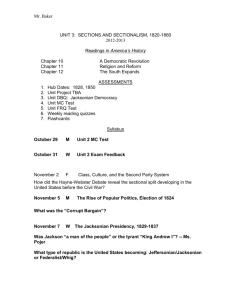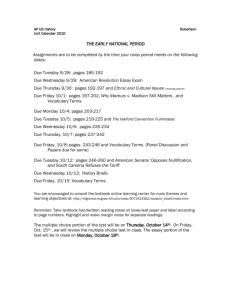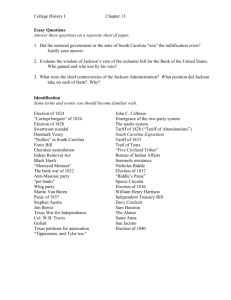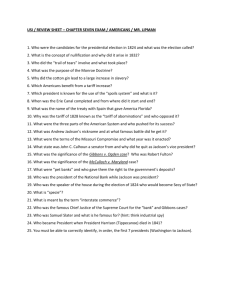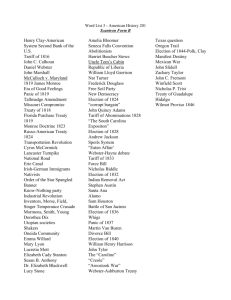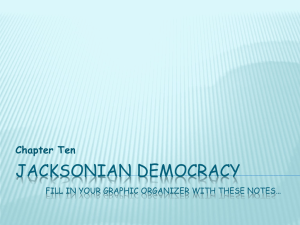Sections and Sectionalism: 1820-1860
advertisement
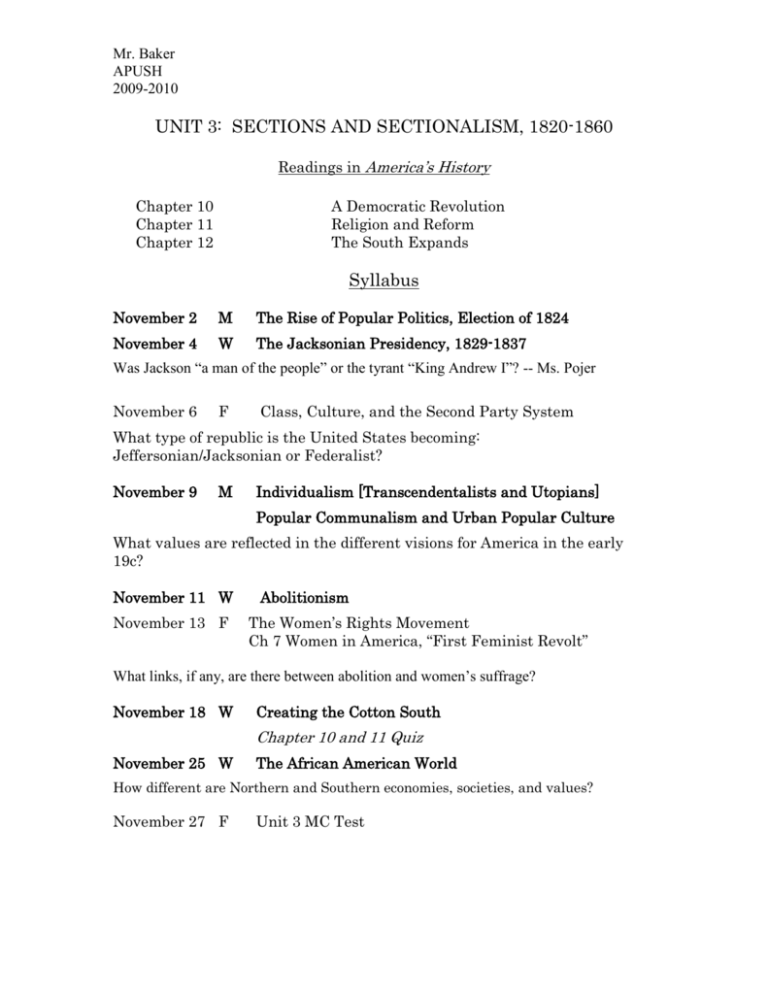
Mr. Baker APUSH 2009-2010 UNIT 3: SECTIONS AND SECTIONALISM, 1820-1860 Readings in America’s History Chapter 10 Chapter 11 Chapter 12 A Democratic Revolution Religion and Reform The South Expands Syllabus November 2 M The Rise of Popular Politics, Election of 1824 November 4 W The Jacksonian Presidency, 1829-1837 Was Jackson “a man of the people” or the tyrant “King Andrew I”? -- Ms. Pojer November 6 F Class, Culture, and the Second Party System What type of republic is the United States becoming: Jeffersonian/Jacksonian or Federalist? November 9 M Individualism [Transcendentalists and Utopians] Popular Communalism and Urban Popular Culture What values are reflected in the different visions for America in the early 19c? November 11 W November 13 F Abolitionism The Women’s Rights Movement Ch 7 Women in America, “First Feminist Revolt” What links, if any, are there between abolition and women’s suffrage? November 18 W Creating the Cotton South Chapter 10 and 11 Quiz November 25 W The African American World How different are Northern and Southern economies, societies, and values? November 27 F Unit 3 MC Test Mr. Baker APUSH 2009-2010 Hub dates 1828 1850 Focus Terms 1. Martin Van Buren 2. Party caucus 3. Political machine 4. Patronage 5. Little Magician 6. Old Hickory 7. Election of 1824 8. Corrupt Bargain 9. Clay’s American System 10. John Quincy Adams 11. Tariff of 1824 12. Tariff of Abominations 1828 13. Andrew Jackson 14. Election of 1828 15. Spoils system 16. Five Civilized Tribes 17. Indian Removal Act 1830 18. Trail of Tears 19. Second Bank of the US 20. Tariff of 1832 21. Nullification 22. The South Carolina Expositionand Protest (1828) 23. Nullification Crisis 24. Force Bill 1833 25. Compromise tariff 1833 26. Texas 27. Whig Party 28. Second Party System 29. John Tyler 30. Preemption Act of 1841 31. Transcendentalists 32. Utopians 33. Seneca Falls Convention 34. Uncle Tom’s Cabin 363 35. Nat Turner’s Rebellion 1831 364 36. William Lloyd Garrison 364 37. Free Soil Party 369 38. Frederick Douglass 369 39. Underground Railroad General Vocabulary 383 Mr. Baker APUSH Chapter 10 Martin Van Buren Election of 1824 Congressional Caucus Corrupt Bargain Clay’s American System John Quincy Adams Tariff of 1824 Tariff of Abominations Democrats Andrew Jackson Election of 1828 Spoils system Kitchen Cabinet Five Civilized Tribes Indian Removal Act 1830 Cherokee Nation vs. Georgia Worcester vs. Georgia Daniel Webster Henry Clay John C. Calhoun Trail of Tears Second Bank of the US Bank war Pet Banks Tariff of 1832 Nullification Crisis Interpose Hayne-Webster Debate Thomas Hart Benton research Force Bill Compromise tariff Texas Labor theory of value Closed shop Blacklist Whig Party Second Party System William Henry Harrison John Tyler Preemption Act of 1841 Ethnocultural politics Charles River Bridge Co. vs. Commonwealth Workingmen’s Parties Anti-Masons Classical liberalism or laissez-faire Roger B. Taney Whigs Transcendentalists Lyceum Movement Ralph Waldo Emerson Henry David Thoreau Walt Whitman Nathanial Hawthorne Herman Melville Emily Dickinson Brook Farm Phalanxes Shakers Oneida Community American Female Moral Utah John H Noyes Minstrel Shows Margaret Fuller Fourierism Mother Ann Lee Minstrel Shows Reform Society Dorthea Dix Grimke Sisters Seneca Falls Convention Margaret Fuller Elizabeth Cady Stanton Susan B Anthony Harriet Beecher Stowe Sojourner Truth Uncle Tom’s Cabin American Colonization Society Liberia Nat Turner’s Rebellion 1831 William Lloyd Garrison Theodore David Weld American Antislavery Society “Civil Disobedience” Gag rule Liberty Party Free Soil Party Frederick Douglass Church of Jesus Christ of the Latter Day Saints (Mormons) Joseph Smith Brigham Young Chapter 13 Gang-labor system Underground Railroad Harriet Tubman 350 350 351 351 352 352 353 353 360 360 361 363 363 363 363 363 364 364 365 365 366 368 368 369 369 404 404 405 Mr. Baker APUSH Advanced Placement FRQs and DBQs: 1969 Were the principal causes of both the War of 1812 and the Mexican War to be found in Western needs and demands? 1973 Why did the institution of slavery command the loyalty of the vast majority of antebellum Southern whites despite the fact that only a small percentage of them owned slaves? 1974 Account for the emergence of utopian communities from the mid-1820s through the 1840s, and evaluate their success or failure. 1979 “American social reform movements from 1820-1860 were characterized by unyielding perfectionism, impatience with compromise and distrust of established social institutions. These qualities explain the degree of success or failure of these movements in achieving their objectives.” Discuss with reference to both antislavery and on other reform movement of the period 1820-1860. 1980 “In the period 1815 to 1860, improvements in transportation and increased interregional trade should have united Americans, but instead produced sectional division and finally, disunion.” Discuss with reference to the impact of improved transportation and increased inter-regional trade on the Northeast, the South and the West. 1990 “Although Americans perceived Manifest Destiny as a benevolent movement, it was in fact an aggressive imperialism pursued at the expense of others.” Assess the validity of this statement with specific reference to American expansionism in the 1840s. 1993 Compare the expansionist foreign policies of Presidents Thomas Jefferson and James K. Polk. To what extent did their policies strengthen the United States? 1993 In what ways did the early nineteenth-century reform movements for abolition and women’s rights illustrate both the strengths and the weaknesses of democracy in the early American republic? 1994 Analyze the ways in which TWO of the following influenced the development of American society. Puritanism during the seventeenth century The Great Awakening during the eighteenth century The Second Great Awakening during the nineteenth century 1995 Analyze the ways in which supporters of slavery in the nineteenth century used legal, religious, and economic arguments to defend the institution of slavery. 1996 Analyze the extent to which TWO of the following influenced the development of democracy between 1820 and 1840. Jacksonian economic policy Changes in electoral politics Second Great Awakening Westward movement
